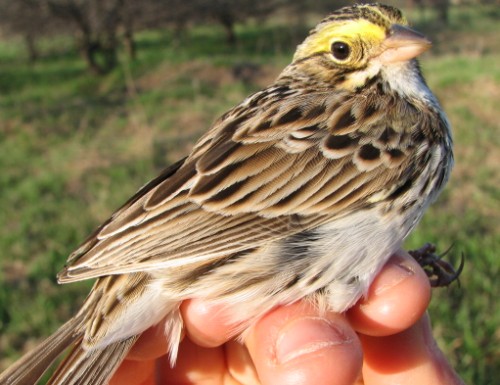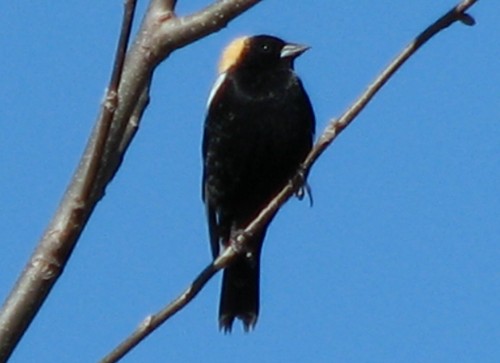|
McGILL BIRD OBSERVATORY |
||||||||||||||||||||||||||||||||||||||||||||||||||||||||||||||||||
Welcome
to the McGill Bird Observatory weekly report.
Click here for a complete listing of our archives.
Banders-in-charge: Barbara
Frei, Marie-Anne Hudson, Lance Laviolette Notes: Spring just keeps on coming! Full coverage was enabled in the 6th week of our spring monitoring season with the help of our wonderful guest bander – Lance Laviolette and the return of MBO’s other leading lady bander, Marie-Anne. Despite a couple of chilly mornings, the sunshine and warmth continued and it was clear to everyone that yes, spring is now here to stay. And with this distinction the buds broke and leaves emerged, no more a delicate promise but a full and blatant beauty of rich dewy green. The frogs continue their chorus and fat tadpoles lazily circle the warm and muddy banks. And the birds… well, 20 new species for the year have arrived! Early Thursday morning as the fog was lifting from the marsh, we emerged from the banding station to begin a net round, when a keen volunteer pointed out the elegant silhouette of an American Bittern slowly rising from the waters by which it had spent the night. Later that day two more species were added to the list of new spring species, as the meow of a Gray Catbird alluded to a ‘bird in the bush’ and the sweet whistle of a Eastern Meadowlark, the first sighting ever for MBO, reminded us that yes, it is the 'spring of the year', as the meadowlark sings.. Lance, our ‘warbler-man’, lived up to his name, for he banded the season’s first warbler on Saturday, a rather shabby second-year Northern Waterthrush. Our small marsh produced another spring newcomer, a rather insistent Virginia Rail which called loudly most of the morning – perhaps complaining about the rather chilly start to the day. In addition to the Northern Waterthrush, a Savannah Sparrow and Hairy Woodpecker were newly banded for the season. Sunday was a lovely day for our tour for the members of COA – our welcome visitors for the day. With several additional eyes we had some excellent observations for the day. This included a reticent Yellow Palm Warbler skulking in the undergrowth and a soaring Northern Rough-winged Swallow among the turbulent cloud of Tree Swallows. The highlight of the day was the wonderfully liquid gurgle and bubble of a Bobolink – appearing from nowhere to sing atop a tree just outside the banding station to the delight and surprise of everyone on site. He flew towards the grassy field just adjacent to MBO – a field that has also brought several other grassland species to the area in recent weeks, including Savannah Sparrows, Vesper Sparrows and Eastern Meadowlarks. Let us hope that McGill University can acknowledge and properly manage this grassland habitat for the disappearing grassland species therein. For more information on Bobolinks and conservation management for the species, please see our grassland conservation page. Finally on Tuesday there were some southerly winds, and over the course of the warm evening a flood of migrants arrived, including the long awaited warblers! Ten new species greeted the happy volunteers on a true spring morning and the newly green treetops of MBO were full of song: Blue-headed Vireo, Northern Parula, Black-throated Green Warblers, Blackburnian Warblers, Black and White Warblers, Ovenbirds, Common Yellowthroats, Eastern White-crowned Sparrows, Magnolia Warblers and Rose-breasted Grosbeaks ... all of which were eagerly invited to come for a visit into the nets for a closer look. Overall, bird migration is still behind this year compared to our numbers of last year, a fact that will hopefully change soon now that the gates of migrations have finally swung open. Due to the incomplete coverage and slower movement there are fewer species and individuals banded in the current spring season compared to week 6 of 2006. But this year we are only 2 species behind the 100 we had sighted at this last year – thanks to our dedicated and sharp-eyed volunteers!
Our top ten species observed have not altered much from last week or the previous years with 2 exceptions. White-throated Sparrows remain in very small numbers this year and are not even close to the top ten species observed, though they were regularly in that list last spring. The swallow numbers have increased on the other hand, Tree Swallows being close to double their number in 2006 and Cliff Swallows also appearing in the top ten this week thanks to birds flying over from the colony near the Arboretum's main gate. Ruby-crowned Kinglets remain at the top of the banded list – though this may be the last week in this position until the fall migration for their numbers were decreasing at the end of the week. The ubiquitous Red-winged Blackbirds remain high on the list, with a fair portion of those banded now being females. Although excited for what we have seen we must also mention what has moved on northwards. Golden-crowned Kinglets, American Tree Sparrows, and Slate-colored Juncos have quietly vanished from our records as they push further towards the Boreal forest to the north. American Robin numbers have steadily decreased and one species ‘missing in action’ is the Fox Sparrow – yet unseen at MBO this spring, and not likely to make this season's list as it is typically one of the earlier migrants. So the questions on all our minds is, what will the gentle south winds blow in for us next week?
|


